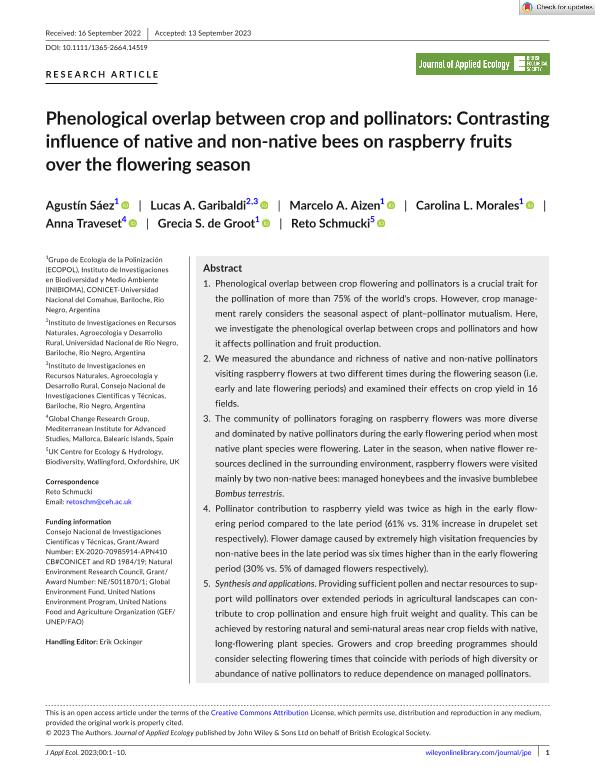Mostrar el registro sencillo del ítem
dc.contributor.author
Sáez, Agustín

dc.contributor.author
Garibaldi, Lucas Alejandro

dc.contributor.author
Aizen, Marcelo Adrian

dc.contributor.author
Morales, Carolina Laura

dc.contributor.author
Traveset, Anna

dc.contributor.author
de Groot, Grecia Stefanía

dc.contributor.author
Schmucki, Reto
dc.date.available
2023-12-01T16:32:28Z
dc.date.issued
2023-10
dc.identifier.citation
Sáez, Agustín; Garibaldi, Lucas Alejandro; Aizen, Marcelo Adrian; Morales, Carolina Laura; Traveset, Anna; et al.; Phenological overlap between crop and pollinators: Contrasting influence of native and non-native bees on raspberry fruits over the flowering season; Wiley Blackwell Publishing, Inc; Journal of Applied Ecology; 2023; 10-2023; 1-10
dc.identifier.issn
0021-8901
dc.identifier.uri
http://hdl.handle.net/11336/219071
dc.description.abstract
Phenological overlap between crop flowering and pollinators is a crucial trait for the pollination of more than 75% of the world's crops. However, crop management rarely considers the seasonal aspect of plant–pollinator mutualism. Here, we investigate the phenological overlap between crops and pollinators and how it affects pollination and fruit production. We measured the abundance and richness of native and non-native pollinators visiting raspberry flowers at two different times during the flowering season (i.e. early and late flowering periods) and examined their effects on crop yield in 16 fields. The community of pollinators foraging on raspberry flowers was more diverse and dominated by native pollinators during the early flowering period when most native plant species were flowering. Later in the season, when native flower resources declined in the surrounding environment, raspberry flowers were visited mainly by two non-native bees: managed honeybees and the invasive bumblebee Bombus terrestris. Pollinator contribution to raspberry yield was twice as high in the early flowering period compared to the late period (61% vs. 31% increase in drupelet set respectively). Flower damage caused by extremely high visitation frequencies by non-native bees in the late period was six times higher than in the early flowering period (30% vs. 5% of damaged flowers respectively). Synthesis and applications. Providing sufficient pollen and nectar resources to support wild pollinators over extended periods in agricultural landscapes can contribute to crop pollination and ensure high fruit weight and quality. This can be achieved by restoring natural and semi-natural areas near crop fields with native, long-flowering plant species. Growers and crop breeding programmes should consider selecting flowering times that coincide with periods of high diversity or abundance of native pollinators to reduce dependence on managed pollinators.
dc.format
application/pdf
dc.language.iso
eng
dc.publisher
Wiley Blackwell Publishing, Inc

dc.rights
info:eu-repo/semantics/openAccess
dc.rights.uri
https://creativecommons.org/licenses/by/2.5/ar/
dc.subject
CROP FLOWERING
dc.subject
CROP POLLINATION
dc.subject
ECOSYSTEM SERVICES
dc.subject
FLOWER RESOURCES
dc.subject
MANAGED POLLINATORS
dc.subject
NATIVE POLLINATORS
dc.subject
POLLINATOR ACTIVITY
dc.subject.classification
Ecología

dc.subject.classification
Ciencias Biológicas

dc.subject.classification
CIENCIAS NATURALES Y EXACTAS

dc.subject.classification
Conservación de la Biodiversidad

dc.subject.classification
Ciencias Biológicas

dc.subject.classification
CIENCIAS NATURALES Y EXACTAS

dc.subject.classification
Agricultura

dc.subject.classification
Agricultura, Silvicultura y Pesca

dc.subject.classification
CIENCIAS AGRÍCOLAS

dc.title
Phenological overlap between crop and pollinators: Contrasting influence of native and non-native bees on raspberry fruits over the flowering season
dc.type
info:eu-repo/semantics/article
dc.type
info:ar-repo/semantics/artículo
dc.type
info:eu-repo/semantics/publishedVersion
dc.date.updated
2023-11-13T15:49:06Z
dc.journal.volume
2023
dc.journal.pagination
1-10
dc.journal.pais
Reino Unido

dc.journal.ciudad
Londres
dc.description.fil
Fil: Sáez, Agustín. Consejo Nacional de Investigaciones Científicas y Técnicas. Centro Científico Tecnológico Conicet - Patagonia Norte. Instituto de Investigaciones en Biodiversidad y Medioambiente. Universidad Nacional del Comahue. Centro Regional Universidad Bariloche. Instituto de Investigaciones en Biodiversidad y Medioambiente; Argentina
dc.description.fil
Fil: Garibaldi, Lucas Alejandro. Consejo Nacional de Investigaciones Cientificas y Tecnicas. Centro Cientifico Tecnologico Conicet - Patagonia Norte. Instituto de Investigaciones En Recursos Naturales, Agroecologia y Desarrollo Rural. - Universidad Nacional de Rio Negro. Instituto de Investigaciones En Recursos Naturales, Agroecologia y Desarrollo Rural.; Argentina
dc.description.fil
Fil: Aizen, Marcelo Adrian. Consejo Nacional de Investigaciones Científicas y Técnicas. Centro Científico Tecnológico Conicet - Patagonia Norte. Instituto de Investigaciones en Biodiversidad y Medioambiente. Universidad Nacional del Comahue. Centro Regional Universidad Bariloche. Instituto de Investigaciones en Biodiversidad y Medioambiente; Argentina
dc.description.fil
Fil: Morales, Carolina Laura. Consejo Nacional de Investigaciones Científicas y Técnicas. Centro Científico Tecnológico Conicet - Patagonia Norte. Instituto de Investigaciones en Biodiversidad y Medioambiente. Universidad Nacional del Comahue. Centro Regional Universidad Bariloche. Instituto de Investigaciones en Biodiversidad y Medioambiente; Argentina
dc.description.fil
Fil: Traveset, Anna. Consejo Superior de Investigaciones Científicas. Instituto Mediterráneo de Estudios Avanzados; España
dc.description.fil
Fil: de Groot, Grecia Stefanía. Consejo Nacional de Investigaciones Científicas y Técnicas. Centro Científico Tecnológico Conicet - Patagonia Norte. Instituto de Investigaciones en Biodiversidad y Medioambiente. Universidad Nacional del Comahue. Centro Regional Universidad Bariloche. Instituto de Investigaciones en Biodiversidad y Medioambiente; Argentina
dc.description.fil
Fil: Schmucki, Reto. UK Centre for Ecology & Hydrology; Reino Unido
dc.journal.title
Journal of Applied Ecology

dc.relation.alternativeid
info:eu-repo/semantics/altIdentifier/url/https://besjournals.onlinelibrary.wiley.com/doi/full/10.1111/1365-2664.14519
dc.relation.alternativeid
info:eu-repo/semantics/altIdentifier/doi/http://dx.doi.org/10.1111/1365-2664.14519
Archivos asociados
